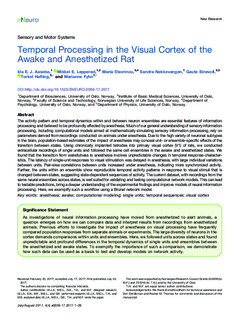| dc.contributor.author | Aasebø, Ida E. J. | |
| dc.contributor.author | Lepperød, Mikkel Elle | |
| dc.contributor.author | Stavrinou, Maria | |
| dc.contributor.author | Nøkkevangen, Sandra | |
| dc.contributor.author | Einevoll, Gaute | |
| dc.contributor.author | Hafting, Torkel | |
| dc.contributor.author | Fyhn, Marianne | |
| dc.date.accessioned | 2018-01-03T14:31:24Z | |
| dc.date.available | 2018-01-03T14:31:24Z | |
| dc.date.created | 2017-09-09T19:04:49Z | |
| dc.date.issued | 2017 | |
| dc.identifier.citation | eNeuro. 2017, 4:e0059-17.2017 (4), 1-26. | nb_NO |
| dc.identifier.issn | 2373-2822 | |
| dc.identifier.uri | http://hdl.handle.net/11250/2474425 | |
| dc.description.abstract | The activity pattern and temporal dynamics within and between neuron ensembles are essential features of information processing and believed to be profoundly affected by anesthesia. Much of our general understanding of sensory information processing, including computational models aimed at mathematically simulating sensory information processing, rely on parameters derived from recordings conducted on animals under anesthesia. Due to the high variety of neuronal subtypes in the brain, population-based estimates of the impact of anesthesia may conceal unit- or ensemble-specific effects of the transition between states. Using chronically implanted tetrodes into primary visual cortex (V1) of rats, we conducted extracellular recordings of single units and followed the same cell ensembles in the awake and anesthetized states. We found that the transition from wakefulness to anesthesia involves unpredictable changes in temporal response characteristics. The latency of single-unit responses to visual stimulation was delayed in anesthesia, with large individual variations between units. Pair-wise correlations between units increased under anesthesia, indicating more synchronized activity. Further, the units within an ensemble show reproducible temporal activity patterns in response to visual stimuli that is changed between states, suggesting state-dependent sequences of activity. The current dataset, with recordings from the same neural ensembles across states, is well suited for validating and testing computational network models. This can lead to testable predictions, bring a deeper understanding of the experimental findings and improve models of neural information processing. Here, we exemplify such a workflow using a Brunel network model. | nb_NO |
| dc.language.iso | eng | nb_NO |
| dc.relation.uri | http://www.eneuro.org/content/4/4/ENEURO.0059-17.2017 | |
| dc.rights | Attribution-NonCommercial-NoDerivatives 4.0 Internasjonal | * |
| dc.rights.uri | http://creativecommons.org/licenses/by-nc-nd/4.0/deed.no | * |
| dc.title | Temporal processing in the visual cortex of the awake and anesthetized rat | nb_NO |
| dc.type | Journal article | nb_NO |
| dc.type | Peer reviewed | nb_NO |
| dc.description.version | publishedVersion | nb_NO |
| dc.source.pagenumber | 1-26 | nb_NO |
| dc.source.volume | 4:e0059-17.2017 | nb_NO |
| dc.source.journal | eNeuro | nb_NO |
| dc.source.issue | 4 | nb_NO |
| dc.identifier.doi | 10.1523/ENEURO.0059-17.2017 | |
| dc.identifier.cristin | 1492395 | |
| cristin.unitcode | 192,15,0,0 | |
| cristin.unitname | Realfag og teknologi | |
| cristin.ispublished | true | |
| cristin.fulltext | original | |
| cristin.qualitycode | 1 | |

